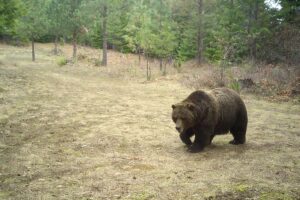
For decades, wildlife conservation has operated under a flawed premise: that nature thrives best when human presence is minimized. Nowhere is this more evident than in grizzly bear recovery efforts, where biologists and policymakers often frame human activity as an obstacle rather than an integral part of the environment itself. This reductionist approach ignores history, practicality, and the long-term sustainability of coexistence.
The Myth of a “Pristine Wilderness: The prevailing conservation narrative assumes that grizzlies existed in an untouched wilderness before human interference. Yet, indigenous peoples across North America coexisted with grizzlies for millennia, shaping ecosystems through hunting, controlled burns, and resource management. The idea that human involvement is inherently disruptive ignores our role in shaping natural landscapes long before modern conservation efforts began.
Grizzly Bear Management in the Selkirk/Cabinet-Yaak Ecosystem: The Selkirk/Cabinet-Yaak ecosystem is one of the designated recovery zones for grizzly bears in the lower 48 states. Unlike other recovery areas, such as Yellowstone or Glacier National Park, this region is interwoven with highways, railroads, and human communities. Conservation efforts here include habitat protection, bear augmentation programs, and conflict mitigation strategies. One of the key initiatives in the Cabinet-Yaak ecosystem has been the augmentation program, which introduced grizzlies from other populations to boost genetic diversity and population numbers. However, human-bear interactions remain a significant challenge. Reports indicate that human-caused grizzly bear mortalities, often stemming from conflicts with livestock or accidental encounters, continue to impact recovery efforts.\
Grizzlies Have Met Recovery Goals—Why Aren’t They Delisted?: Despite these challenges, grizzly populations in the Selkirk/Cabinet-Yaak ecosystem have met the recovery benchmarks set by the U.S. Fish and Wildlife Service. The population has stabilized, genetic diversity has improved, and habitat protections have ensured long-term viability. Yet, federal agencies continue to delay delisting, citing broader concerns about connectivity between grizzly populations across the Northern Rockies Recent policy shifts have further complicated the delisting process. The U.S. Fish and Wildlife Service has proposed managing grizzlies as a single population across multiple ecosystems rather than evaluating individual recovery zones separately. While this approach may benefit areas with struggling populations, it unfairly keeps recovered populations—like those in the Selkirk/Cabinet-Yaak ecosystem—under federal protection longer than necessary.
The Need for a Balanced Approach: Biologists must recognize that humans are as much a part of the natural environment as grizzlies themselves. Sustainable conservation should prioritize coexistence rather than exclusion. Strategies like community-led bear management, ranching practices that deter predation, and policies that acknowledge the legitimate role of humans in shared landscapes will yield better long-term results. If grizzly recovery efforts continue to treat human presence as an obstacle, they risk fostering resentment, economic hardship, and impractical conservation strategies. It’s time to embrace a more holistic view—one that recognizes that nature and humanity are inextricably linked, rather than at odds.
Darrell Kerby
Bonners Ferry

You can’t accurately compare human interaction with grizzly bears today versus back in the 1800’s.
We have a much higher human population now then back then which causes more disturbance of their habitat and conflicts with humans. We must respect their presence and use smart tools to deter grizzly bears from attacking cattle and sheep. We must understand the times of the year when they should not be disturbed so they can continue to thrive.